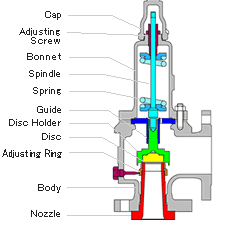Pressure Relief Valve
Table of Contents
| Conventional Pressure Relief Valve [1] |
|---|
Advantages
Conventional
- Most reliable type if properly sized and operated
- Versatile — can be used in many services [4]
Balanced Bellows
- Relieving pressure unaffected by back pressure
- Handle greater built-up backpressure
- Spring corrosion-protection
- Good temperature and chemical properties [4]
Disadvantages
Conventional
- Relieving pressure affected by back pressure
- Susceptible to chatter if built-up back pressure is too high [4]
Balanced Bellows
- Bellow is susceptible to fatigue/rupture
- Possible external release of flammables/toxics
- Requires separate venting system [4]
Materials
A wide variety of materials are suited towards the needs of pressure relief valves. Common materials include brass, plastic, and aluminum. Brass is most commonly used, and is relatively economical. Plastic is used if cost-savings are a primary concern. Aluminum is typically specified if lower weight is a consideration. Various stainless steel grades (e.g. 303, 304, 316) are also available. Stainless steel is used for use with corrosive fluids, when cleanliness of the fluid is important, or in the scenario of high operating temperatures. Springs inside the valves are typically made of carbon steel or stainless steel. Various seal materials can also be specified, including Buna-N, Fluorocarbon, EPDM, Silicone, and Perfluoroelastomer [3].
Suppliers
Linked below are suppliers of Pressure Relief Valves:
Contributors:
| User | Last Update |
|---|---|
| Former user (Deleted) | 1356 days ago |
| Former user (Deleted) | 1370 days ago |
| Former user (Deleted) | 1370 days ago |
| Former user (Deleted) | 1436 days ago |
Faculty Advisor: Rachel Malevich




